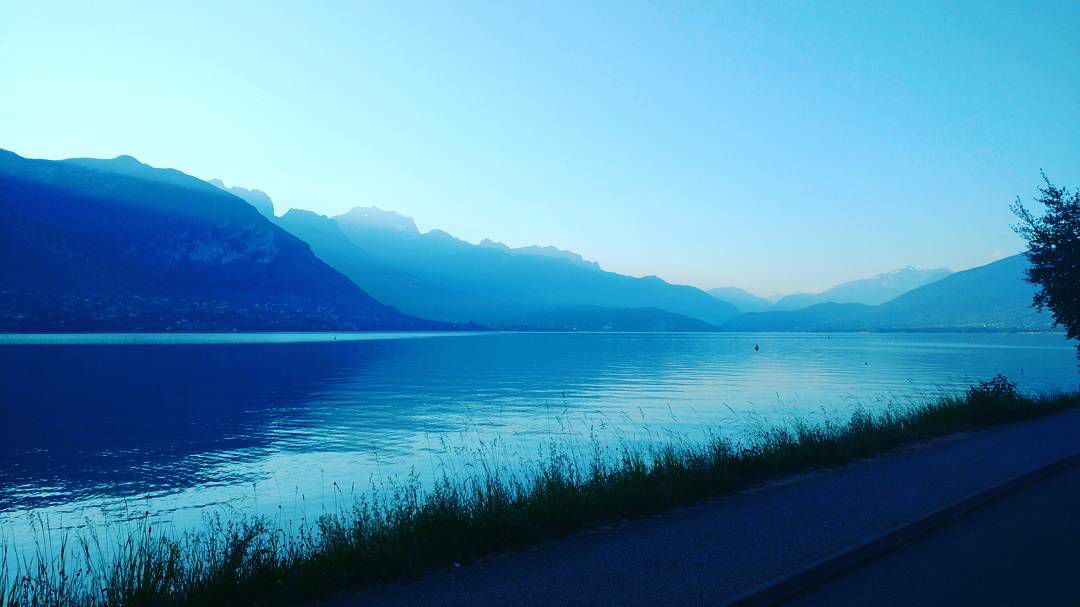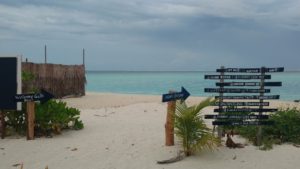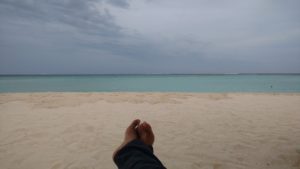Visiting the local islands in Maldives was an experience that rekindled my belief in the simple joys of life. I spent a night each in Maafushi and Gulhi, two islands traditionally inhabited by locals that have only recently started welcoming tourists. Opening up of the local islands is revolutionary and it has created stark contrasts.
On one hand are the island resorts redefining luxury. On the other, there are the simple islanders living their simple lives in tiny islands. It’s the honeymoon capital of the world and also the country with the highest divorce rate. As per UN estimates, the average 30 year old Maldivian woman would have already been divorced thrice. It’s the land where bikinis and burqas coexist.
Both Maafushi and Gulhi are well connected to Male by local ferries and you can get there from Male in under 2 hrs and for less than $2. But be warned, the ferries are infrequent. Research the ferry timings before drawing up the itinerary.
Maafushi is just about a kilometre long and a quarter of a kilometre wide. Yet it is the capital of independent travel scene in Maldives and is already full of guesthouses. It also boasts of three PADI certified dive centres, water sports facilities and bikini beaches for foreign tourists.
Maafushi is a great launchpad for Scuba diving, snorkelling or dolphin watching trips. The night fishing trips are also very popular. Guest houses typically charge $25-$30 per person for the fishing trips if they are able to get together a group of 4 or more. This includes a dinner prepared from your own fresh catch and served beachside! Million dollar views of the sun setting into the ocean are also thrown in complimentary.
 |
| Catch of the day |
I also did a snorkelling trip organised by Crystal Sands Hotel where they took us to three snorkelling points, including the highly acclaimed (and rightly so) DM Giri. Our group was provided the services of 3 well trained and friendly guides and hygienic and neat equipment for $35. Well worth it. However, I recommend you ask around at a few operators before booking your desired excursions to get the best rates.
Despite having welcomed its first set of tourists barely 7 years ago, Maafushi today is heavily commercialised. To get a real taste of Maldivian life, you have to look a little further still.
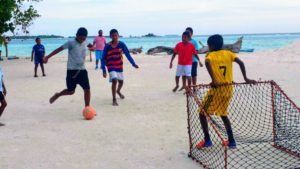 |
| Stadium with a view |
The tiny island of Gulhi, occupying no more than 1 sq km, is a microcosm. I saw toddlers playing football right next to the turquoise ocean, where a strong kick could send the ball soaring into the blue. A few paces away, there were local teenage girls playing beach volleyball in burqas. Yes, you read it right. Beach volleyball in burqas. Only a few paces further ahead is the bikini beach. It is cordoned off for tourists, primarily European revellers to swim, canoe, snorkel and sunbathe and is out of bounds for locals. Conversely, it is forbidden for tourists to dress immodestly anywhere outside the designated bikini beach. At 5:30 on an August evening, I had the pleasure of having the beach to myself.
For the locals, evenings are meant for relaxation. The womenfolk gather together to play a few rounds of cards, smoke sheesha and chat up. Some take their small kids to the beach. The men are also back home by then with their fresh catch. Fishing is still the prime profession for locals and a very dignified one. Fishermen earn more than better educated people in the service sector.
 |
| Wall Painting on the premises of a local school in Maafushi |
I stayed at Tropic Tree Guest House. It’s one of only three options available on the island presently. When an island guest house in Gulhi has its custom designed toiletteries, you know they are ambitious and are in it for the long run. Ibrahim, whose uncles own the place, manages the front desk with cousin Yaan. Ibrahim gave us a tour of the entire island and even took us home. A long conversation with him taught us a lot about the local culture.
The tiny island having no more than 30 houses has a grand mosque, a health centre and a school and a municipal council. It even has a boat factory where boats get manufactured or refitted and repaired.
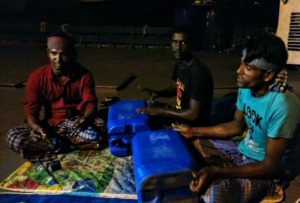 |
| Bangladeshi crew of a dhoni singling away in the moonlight |
Later in the night I had the good fortune of sitting next to the Bangladeshi staff of a dhoni (local boat) and hearing them sing. The dhoni transports cement from Male to the islands and anchors at the destination island for the night. The crew sleeps aboard. The entire staff had come from Bangladesh, as have many more of their countrymen who staff various guest houses, resorts, restaurants and supermarkets in Male. Some of them had not been home for more than 5 years. They used empty water jerrycans as drums and sang soul stirring folk songs. They sang of the pre-partition days when Hindus and Muslims lived next to each others as brothers, singing Bengali songs together and attending festivities at each others’ homes. They sang of longing for their motherland. A land they left in search of opportunities. The song ends with plans of returning home the next month. They sing it knowing very well that they are not going home. As the moonlight shone on and the ocean shimmered under it, their songs touched a chord inside. Their way of life reminded me that not much is required to experience joy, hope and contentment.
 |
| Till we meet again |




